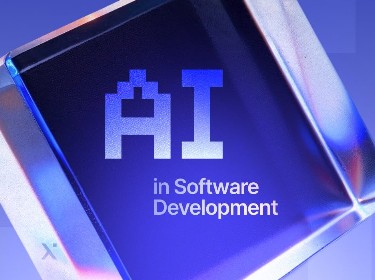Rapidly growing revenues generated by AI applications are attracting newcomers and fueling the industry’s development. Developers are always on the lookout for more efficient machine learning models, languages, frameworks, and libraries. In many aspects, the right choice of technologies determines a project’s level of success.
Artificial intelligence (AI) applications currently thrive in an increasingly digitized world that generates large amounts of data. Recent advances in machine learning and deep learning algorithms have allowed AI systems to perform cognitive tasks that were previously attributed exclusively to humans, such as sensing emotion, making implicit judgments, and driving.
The speed of AI adoption has been increasing steadily over the years. PwC estimates that AI will generate around 15.7 trillion USD of economic gain by 2030.
This technology is becoming predominant across business domains from retail to banking to marketing, and many others. Machine learning algorithms are rooted in apps and offer various automation and prediction features, making user tasks easier to complete and generating valuable insights.
For every potential use case or business idea, there’s a plethora of tools available on the market which makes it harder to navigate. Each AI programming language has its own perks that make it better for some applications and less appropriate for others. Python, Java, R, Julia, and C++ are currently leading the list of the top used tools for development.
Read on to find out more about these languages, discover what they offer in terms of AI development, and learn how to select the best set of tools for your next project.
What are the best programming languages for AI and machine learning in 2025?
Some programming languages were created explicitly for building artificial intelligence solutions while others were chosen based on the preferences of the developers’ community. These languages were used to create frameworks that offer machine learning models and templates for creating more efficient AI applications.
Among the most popular ones are Python, Java, R, Scala, Lisp, Prolog, Julia, and C++. Languages such as Rust, MATLAB, and Haskell also offer certain advantages. Let’s take a deeper look.
If you would like a more comprehensive overview, you can approach our artificial intelligence and machine learning consulting services.
Python
![]()
Python was developed in 1991 by Guido van Rossum as a high-level, interpreted, and object-oriented programming language that promotes code readability and simplicity principles. Despite being a general-purpose programming language, Python has established itself as the most popular language among AI developers.
The main reason behind this popularity is a large number of useful libraries as well as excellent community support. Python is often characterized by beginners as easy to learn. Some of the biggest advantages of Python are platform independence and an extensive selection of frameworks for machine learning.
It’s not all sunshine with Python development as it also has some drawbacks. Being a high-level language takes its toll on speed. Python is much slower compared to C++-inspired tools. It is not compiled but more dynamically typed. This makes it slower and also leads to applications consuming a large amount of memory.
Python’s high memory consumption can also be attributed to its flexibility when it comes to data types. It is an interpreted language and naturally, most of the errors appear during runtime. That’s why Python boasts of its thorough exception handling mechanisms.
Python is well suited for data collection, analysis, modeling, and visualization. It offers a variety of file sharing and export options as well as good support for accessing all major database types. The language has an extensive ecosystem of libraries and frameworks for AI development. Some of the most popular libraries for machine learning and deep learning written in Python are TensorFlow, Scikit-Learn, Keras, Pandas, matplotlib, and PyTorch.
Summary
Pros:
- Easy to learn
- Code readability
- Simplicity
- Community support
Cons:
- Slow
- High memory usage
- Errors appear at runtime
Top use cases:
- Server backend
- Machine learning frameworks
- Data science
- Visualization
C++
C++ was invented in 1985 by Bjarne Stroustrup to serve as an extension of the C programming language. It was originally designed as a language for resource-constrained and embedded systems with performance, efficiency, and flexibility as design priorities. Nevertheless, it has found its place in many other contexts such as desktop applications, backend of servers, video games, and artificial intelligence.
C++ a general-purpose, compiled, and object-oriented programming language that provides high-level abstraction features while also allowing low-level functionality such as efficient memory manipulation and direct access to other system resources.
Memory allocation is a distinct feature of C++, offering extreme flexibility in creating complex data structures and derivative functions. Pointer variables are the centerpiece of this process. Misuse of pointers, however, may lead to system crashes.
Most of the security concerns in C++ are attributed to using friend functions, global variables, and pointers. This language does not offer garbage collectors that automatically dispose of unnecessary data. This responsibility is imposed on the developers.
Some of the most popular AI frameworks have been developed using C++. There is a general notion in the AI development community that it works to have a fast and efficient framework implementation using C++ and a versatile and easy-to-use interface for that framework implemented in Python. Combining the best of both worlds, so to speak.
The most popular machine learning framework, TensorFlow, was created using C++. It was also used to implement the deep learning framework called Convolutional Architecture for Fast Feature Embedding (Caffe). Other C++ implementations with Python bindings include CNTK, mlpack, DyNet, Shogun, and FANN.
Summary
Pros:
- Efficient memory access
- High performance
- System programming
Cons:
- Concepts difficult to grasp
- Low security, no garbage collection
Top use cases:
- Desktop applications
- Server backend
- Games
- ML libraries
Java
![]()
Java was developed by James Gosling in 1995 as a general-purpose, high-level, and object-oriented programming language. In syntax, it is similar to C and C++ languages, however, Java is designed to be self-contained and has few dependencies.
With its Write Once Run Anywhere (WORA) mentality, Java was one of the first languages to create platform-independent software. Thanks to Java virtual machine (JVM), compiled Java programs can run across different chip architectures and operating systems.
Java is unique in many ways and offers distinct features such as reflection and runtime code modification. It has a very large developer community and is a favored choice for client-server web applications. It does not have explicit pointers and fosters a security manager that defines access restrictions for classes. Java also has extensive tools for multithreading.
The language consumes a large amount of memory and exhibits slower performance than natively compiled languages such as C++. Memory management in Java is done via a garbage collector that affects the performance of the application due to the necessity to pause threads and allow the garbage collector to run. Java is somewhat verbose and can be hard to read and interpret.
Java is considered useful for various AI development tasks, namely data cleaning, importing and exporting data, statistical analysis, deep learning, machine learning, natural language processing (NLP), and visualization of data.
AI is closely related to Big Data and the most popular Big Data frameworks such as Fink, Hadoop, Hive, and Spark were developed in Java. It also offers multiple frameworks for AI development, including Weka, Java-ML, H2O, DeepLearning4j, and MOA.
Summary
Pros:
- Platform independence
- Runtime code modification
- Community support
- High security
- Multithreading
Cons:
- High memory consumption
- Slow performance
- Boilerplate code
- Low readability
Top use cases:
- Server backend
- Data science
- Machine learning
- IoT applications
Lisp
Lisp is a family of languages that was designed by John McCarthy in 1958. It is the second-oldest high-level programming language in the world (Fortran is just a year older). The first real-world implementation of Lisp was carried out by Steve Russell soon after its invention. Throughout the years, developers have created many dialects of Lisp. The most famous Lisp dialects include Racket, Common Lisp, Scheme, and Clojure.
The main drive behind Lisp was to create a practical mathematical representation in code. Due to this inherent advantage, it became the preferred language for AI research. Many computer science ideas such as recursion, tree data structures, and dynamic typing were first implemented in Lisp.
Lisp is very efficient and allows for the fast execution of programs. When compared to C++ or Java, Lisp applications are smaller, faster to develop, execute more quickly, and are easier to maintain.
Programming languages from the Lisp family can be used to create macros that serve as extensions for other software. The language is modifiable and enables developers to create their own constructs. It is, however, highly complex and not very easy to read.
Lisp has several libraries for machine learning. One of the most extensive solutions is CLML. The mgl library is often used for developing high-performing machine learning algorithms. Antik is an excellent library for numeric code, while mgl-mat and LLA also offer great solutions for artificial intelligence.
Summary
Pros:
- Efficiency
- Speed
- Maintainability
Cons:
- Complexity
- Low readability
Top use cases:
- AI research
Prolog
![]()
Prolog is a logic programming language often used in artificial intelligence software and computational linguistics. The language was developed by Alain Colmerauer and Philippe Roussel in 1972. Its creation was inspired by the Horn clause concept, a logical formula implemented in a rule-like form that has useful properties used in logic programming.
Prolog is primarily a declarative programming language meaning that program logic is expressed through relations between facts and rules. A computation in Prolog is carried out by running a query over the implemented relations.
As the most popular logic programming language nowadays, Prolog is used for programming expert systems, proving theorems, automated planning, and natural language processing. In general, Prolog would be suitable for any task that involves the heavy use of rule-based logical queries such as database interfacing and voice control systems.
Prolog is valued in the AI community for its impressive track record of solving tough AI problems. Some developers are fans of its declarative semantics. It is capable of effectively expressing problem relationships in AI through its inherent inference mechanisms. Prolog also has a rich set of extensions that accelerate the development process.
Prolog’s complex logic often leads to errors due to developer mistakes. This imposes a challenge since the language does not offer great tools for debugging. Therefore, quality assurance for Prolog programs is challenging and requires procedural interpretation.
Prolog has been used to create a fair share of AI libraries. For example, Zamia-AI is a framework that provides components and tools to develop open-source speech and natural language processing systems. The Prolog-based mlu, cplint, and cplint_datasets machine learning libraries also prove to be very handy tools for implementing artificial intelligence.
Summary
Pros:
- Declarative semantics
- Built-in mechanisms for inference
- Extensibility
Cons:
- Complex logic leads to errors
- Poor testability
Top use cases:
- Logic programming
R
R was created by Ross Ihaka and Robert Gentleman in 1995. It’s one of the languages that was developed primarily for the statistical analysis and graphical representation of data. It is open-source and attracts a wide AI community. R is especially useful for AI development that involves time series analysis, statistical tests, linear and nonlinear modeling, and clustering.
Tools such as RStudio and Jupyter make it very easy to develop applications in R. The language is object-oriented, very extensible, and allows other languages to manipulate its objects. One of the biggest advantages of R is its efficiency in data handling and analysis. It also offers great plotting capabilities. On the downside, R is not easy to learn. It is slow and suffers from security issues.
Some of the most popular AI frameworks in R include:
- Gmodels: a collection of tools for fitting models
- Tm: a framework for text mining applications
- RODBC: an open database connectivity interface for R
- OneR: a framework for implementing one rule classification algorithms.
Summary
Pros:
- Efficient data handling and analysis
- Large developer community
- Extensibility
Cons:
- Hard to learn
- Low performance
- Security issues
Top use cases:
- Data science
- Visualization
Scala
![]()
Scala is a statically typed, high-level, object-oriented, and functional programming language. Scala was developed at EPFL in 2004. It was originally developed to have Java’s benefits while at the same time mitigate some of its criticized deficiencies.
Scala is fully interoperable with Java, so libraries written in one language can be used in developing applications with the other. Having static types, Scala helps developers write software with fewer bugs. Its JVM and Javascript runtimes enable the development of high-performance software systems with access to shared resources and a multitude of libraries.
Expressiveness, concise syntax, and concurrency principles make Scala an easy-to-use and efficient programming language. It allows developers to use both object-oriented and functional programming concepts. Scala inherits Java’s security and can interoperate with it seamlessly.
Programs written in Scala have much less boilerplate code compared to those written in Java and this adds to its usability and simplicity. Scala also features a toolset for writing concurrent applications that can easily scale and process real-time streams of data.
Due to these features, Scala has become an integral component of data analysis applications including Apache Flink, Apache Spark, Apache Kafka, and Akka Stream.
The biggest disadvantages of Scala are lack of community support, low adoption, limitations on backward compatibility, and a steep learning curve.
The most popular machine learning tool for Scala is Breeze. This library combines the functionalities of Matlab and the NumPy library from Python. It emerged as a combination of the ScalaNLP and Scalala projects. Breeze offers a lot of the computing tools necessary to develop modern AI systems.
Summary
Pros:
- Simplicity
- Efficiency
- Expressiveness
- Concurrency
Cons:
- Low adoption
- Poor backward compatibility
- Steep learning curve
Top use cases:
- Data processing
- Microservices
- Data pipelines
- Machine learning systems
- Video transcoding
Rust
Rust is a multi-paradigm programming language designed for performance, safety, and safe concurrency. Its syntax is similar to C++, but Rust is a much more memory-safe language. It does not permit null pointers, dangling pointers, or data races. Instead of using automated garbage collection, memory and other resources are managed through a dedicated mechanism that provides deterministic management with low overhead.
Contributing to safety is an ownership system where all values have a unique owner, and the scope of the value is the same as the scope of the owner. Rust is also easily extensible to other languages through macros. It is mostly used in web development and for building operating system components.
Rust can be difficult to learn and requires knowledge of object-oriented programming concepts. It has a slow compiler and the resulting binary files are quite large. There is a limited number of machine learning libraries written explicitly in Rust. However, developers can find many bindings to standard machine learning libraries such as PyTorch or TensorFlow.
Summary
Pros:
- Performance
- Safety
- Concurrency
Cons:
- Difficult to learn
- Slow compiler
- Large binary files
Top use cases:
- Web development
- OS development
Julia
![]()
Julia is a dynamically typed general-purpose programming language. It is a very suitable choice for numerical analysis and computational scientific analysis. Despite its high-level nature, it offers a lot of low-level programming features as well. Julia has been used by big business corporations mostly for time-series analysis, risk analysis, and even space mission planning.
This programming language focuses on delivering high performance and has built-in support for a package manager. It offers data visualization, multidimensional dataset manipulation, reliable tools for deep learning, and support for parallel and distributed computing.
Since the language was designed primarily for numerical and scientific computing, Julia has become very popular in research and scientific communities. It offers an abundance of libraries such as differential equations ecosystem DifferentialEquations, optimization tools JuMP and Optim, iterative linear solvers IterativeSolvers, Fast Fourier transforms AbstractFFTs, and others.
For statistical analysis and data science, Julia provides DataFrames to work with datasets and perform common data manipulations. JuliaGraphs packages offer the opportunity to work with combinatorial data. Julia integrates nicely with databases through JDBC, ODBC, and Spark drivers.
For machine learning, Julia offers the MLJ package. It has a unified interface to common machine learning algorithms. In addition, developers can make use of Flux and Knet for deep learning purposes.
Summary
Pros:
- High performance
- Automated memory management
Cons:
- Poor community support
Top use cases:
- Numerical analysis
- Computational scientific analysis
- Time-series analysis
- Machine learning
Haskell
Haskell was developed in 1990 and named after mathematician Haskell Brooks Curry. Haskell is a general-purpose, compiled, and purely functional programming language. The language is considered to be safe due to its flexibility in debugging and error handling.
Haskell has strong abstraction capabilities and built-in memory management. Its code is highly reusable and easy to understand. This language is favored by many developers because it increases productivity.
Haskell’s learning curve, however, is fairly steep when compared to other languages commonly used for AI development. Haskell is a lazy language, which means that values are evaluated only when needed. This often leads to difficulties in memory allocation.
One of the most popular Haskell libraries for machine learning is HLearn. The library exploits the algebraic structures inherent in learning systems and contains several useful templates for implementation. Haskell also has a TensorFlow binding which can be used for deep learning.
Parallel and Concurrent are used for parallelism and concurrency, both important features of deep learning. Machine learning libraries implemented natively in Haskell are scarce which makes its usage in AI somewhat limited. Quite a few companies, however, have use Haskell to power their business processes.
Summary
Pros:
- Strong abstraction capabilities
- Built-in memory management
- High maintainability
Cons:
- Poor community support
- Steep learning curve
- Memory allocation issues
Top use cases:
- Finance and banking apps
- Aerospace and defense firmware
- Web development
MATLAB
![]()
MATLAB (MATrix LABoratory) is a closed source programming language and numeric computing environment. MATLAB was developed by the MathWorks company but the idea was coined back in the 1960s by Cleve Moler in his Ph.D. thesis. It is very useful for efficient matrix manipulation, plotting, mapping graphical user interfaces, and integrating with libraries implemented in other languages.
The language and additional specialized modules are mostly used by researchers and scientists. With its add-on modules, MATLAB enables data analysis and image processing. It also features relatively advanced machine learning toolboxes that streamline AI development.
Some of the most prominent advantages of MATLAB are ease of use and a rich library of ready-to-use functions that can automate the development of many common computing applications. It offers versatile tools for plotting algorithms and function outputs, and platform independence.
With cross-platform app development, MATLAB applications can run across various platforms. However, it’s important to consider that MATLAB requires a relatively expensive license and its nature as an interpreted language can lead to slower performance and higher memory usage.
Summary
Pros:
- Ease of use
- Rich library pack
- Platform independence
Cons:
- Expensive license cost
- Memory intensive
Top use cases:
- Control theory
- Data analysis
- Machine learning
- Scientific computing
Choosing a programming language for AI development
Selecting the right tech stack is vital for a project’s success. The best way to start is by defining the task at hand. After a clear definition of what the task is and what the expected results are, there has to be a clear statement of how machine learning, deep learning, or some other data-driven approach can help in achieving these goals.
Once you are sure that AI techniques are a good fit, the next most important factor is the development team’s experience. Find out what is the preferred programming language among the developers in your team.
The next thing to determine is the actual scale at which the AI software will be used. This will decide whether the selection of tools and programming languages can efficiently support that scale. Finally, it is important to determine if your team has an interest in developing your own tools, or if you want to make use of available tools that will help you move faster, sacrificing flexibility.
Conclusion
Automated processes are the most attractive trait of AI software for businesses. This includes recent developments like robotics and machine learning. AI-driven software systems are capable of performing a variety of tasks without involving an extra workforce. It saves you a lot in operational costs.
Integrating AI software into an existing diverse business ecosystem requires a variety of programming tools, including different languages, frameworks, and libraries. These tools often demand extreme levels of proficiency and expertise. An experienced AI development partner can help you navigate through the complex development process and turn your project into a successful one. These companies often practice full-cycle product development and can supervise development from ideation to deployment and market launch.




